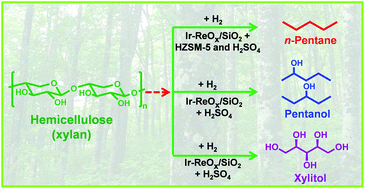
First, rhenium was introduced into an iridium impregnated silica. The resulting catalyst was capable of producing xylitol from xylan (79% yield) if used in combination with sulphuric acid in an aqueous reaction. Some success in achieving a partial reduction to pentanol was then observed when an organic solvent was introduced to the reaction. Finally, full hydrogenolysis to give pentane (in 70% yield) was accomplished by adding a HZSM-5 zeolite to the biphasic reaction.
The heterogeneous catalyst is recoverable and can be reactivated to continue providing a good yield of pentane. Thus a new flexibility to woody biomass processing has been demonstrated, complementing the more prevalent studies on cellulose and lignin.
This work is included in a online collection showcasing work presented at the 3rd International Symposium on Green Chemistry held in La Rochelle, France on 3rd-7th May 2015. Access the full collection of articles here.
Selective transformation of hemicellulose (xylan) into n-pentane, pentanols or xylitol over a rhenium-modified iridium catalyst combined with acids
Sibao Liu, Yasuyo Okuyama, Masazumi Tamura, Yoshinao Nakagawa, Akio Imai and Keiichi Tomishige
Green Chem., 2016, Advance Article. DOI: 10.1039/C5GC02183A










